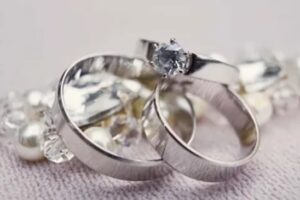
A custom engagement ring offers a uniquely meaningful way to symbolize love. Whereas regular rings lack personalization, custom jewellery reflects individual styles and preferences. Consequently, this process ensures a bespoke engagement ring, incorporating carefully chosen materials and design elements. Moreover, customizing a ring allows creative freedom and quality control, thus increasing its sentimental value. Therefore, it is crucial to understand the process, which includes setting a budget, selecting an appropriate jeweller, and finally, personalizing the design.
This guide will guide you through the steps to ensure your custom engagement ring is stunning and meaningful.
Step 1: Decide on Your Budget for Bespoke Engagement Ring
Before you start designing, you should decide on your price range. This is an important first step as it allows you to create smart alternatives to fit your machine lifestyle. Knowing how much you can spend will help you choose the right material and design.
To determine your budget:
- Assess Your Finances: Look at your savings and decide how much you can afford to spend on the ring without straining your finances.
- Research Costs: Get an idea of how much different materials and designs cost. This will give you a realistic view of what you can get for your money.
- Set a Limit: Decide on the maximum amount you’re willing to spend. Stick to this limit to avoid overspending.
By setting a budget, you ensure that you can create a beautiful ring without breaking the bank. This step helps you prioritize what matters most in your design.
Step 2: Choose the Right Jeweler
Before you start designing, you need to determine the range of fees. This is a critical first step as it allows you to make smart choices about how your device lives. Knowing how many tons you can spend will help you choose the right fabrics and format.
- Research Local Jewelers: Look for jewellers who specialize in bespoke jewellery. Check their reviews and see what other customers say about their work.
- Visit Jewelers: Visit a few jewellers to see their work firsthand. Ask to see examples of their bespoke designs.
- Ask Questions: When you meet with a jeweller, ask questions about their process. How long does it take to create a bespoke ring? What materials do they recommend? How do they ensure the quality of their work?
- Check Credentials: Make sure the jeweller has the proper certifications and experience. A reputable jeweller will have credentials that show their expertise.
By choosing a skilled jeweller, you ensure that your custom engagement ring will be crafted with care and precision. A good jeweller will guide you through the design process and help you make the best choices.
Step 3: Understand the Basics of Diamonds and Gemstones
Understanding the basics of diamonds and gemstones is undoubtedly essential to designing your own engagement ring. Indeed, knowing what to look for will consequently help you select nice stones for your ring. Therefore, here’s an easy guide to get you started.
The Four Cs of Diamonds
Diamonds are graded based on four main factors, known as the Four Cs: Cut, Color, Clarity, and Carat. Here’s what each one means:
- Cut: The cut refers to how well the diamond has been shaped and faceted. A well-cut diamond reflects light beautifully and sparkles brightly. Common cuts include round, princess, and emerald.
- Colour: Diamonds come in various colours, but the most valuable ones are usually colourless. The colour scale ranges from D (colourless) to Z (light yellow or brown). Colourless diamonds are rare and more expensive.
- Clarity: Clarity measures the number of flaws or inclusions in a diamond. The fewer the inclusions, the clearer and more valuable the diamond. Clarity is graded from Flawless (no inclusions) to Included (many inclusions).
- Carat: Carat refers to the weight of the diamond. Larger diamonds are rarer and more expensive. However, carat is not the only factor to consider. A well-cut, smaller diamond can be more stunning than a larger, poorly-cut one.
Tips for Choosing Gemstones
When selecting gemstones for your bespoke design, consider these tips:
- Personal Preference: Choose a stone that reflects your partner’s taste and style.
- Durability: Consider how often your partner will wear the ring. Choose durable stones for everyday wear.
- Budget: Some gemstones are more affordable than diamonds. Explore different options to find the best fit for your budget.
- Symbolism: Think about what each gemstone represents and choose one that has special meaning for you and your partner.
By understanding the basics of diamonds and gemstones, you can thus make informed decisions when designing your custom engagement ring. Consequently, this knowledge will help you create a ring that is not only beautiful but also meaningful and uniquely yours.
Step 4: Select a Style
Choosing the style for your custom engagement ring is an exciting part of the process. The style sets the overall look and feel of the ring. Here are some popular styles to consider:
Different Ring Styles
- Solitaire: A solitaire ring features a single gemstone. This classic style is elegant and timeless. It highlights the beauty of the central stone.
- Halo: A halo ring has a central gemstone surrounded by smaller stones. This style adds extra sparkle and makes the central stone look larger.
- Vintage: Vintage rings have intricate designs and a timeless charm. They often feature detailed metalwork and unique settings.
- Three-Stone: A three-stone ring has a central gemstone flanked by two smaller stones. This style symbolizes the past, present, and future of your relationship.
Choosing the Right Style
To select the right style, consider these factors:
- Your Partner’s Taste: Think about the jewelry your partner usually wears. Do they prefer classic, modern, or vintage styles?
- Lifestyle: Choose a style that fits your partner’s lifestyle. If they are very active, a simpler design might be more practical.
- Hand Shape: Different styles complement different hand shapes. For example, elongated styles can make short fingers appear longer.
- Personal Touches: Consider adding elements that reflect your partner’s personality, such as their favourite colour or a meaningful symbol.
By choosing the right style, you ensure that your custom engagement ring will be cherished and admired.
Step 5: Design the Setting
The setting is crucial in your bespoke design. It holds the gemstone in place and affects the ring’s appearance and durability. Here are common settings to consider:
Types of Settings
- Prong: Prong settings use metal claws to hold the gemstone. This setting allows light to enter the stone, enhancing its sparkle. It is popular for solitaires.
- Bezel: A bezel setting surrounds the gemstone with a metal rim. This setting is secure and protects the stone from damage. It has a modern look.
- Pavé: Pavé settings feature small gemstones set close together. This setting adds extra sparkle and complements the central stone.
- Channel: In a channel setting, gemstones are set between two metal strips. This setting is secure and gives a sleek, modern look.
Importance of the Setting
The setting affects the ring’s durability and appearance. Here’s why it’s important:
- Durability: Some settings, like bezel and channel, offer more protection for the gemstone. They are ideal for active lifestyles.
- Appearance: The setting can enhance or change the look of the ring. Prong settings make the stone look larger, while pavé adds extra sparkle.
- Comfort: The setting should be comfortable to wear. Avoid settings that snag on clothing or feel uncomfortable on the finger.
By carefully choosing the setting, you ensure your custom engagement ring is beautiful and practical.
Step 6: Personalize the Ring
Personalizing your custom engagement ring undoubtedly makes it truly unique. Moreover, adding special touches ensures the ring is not only one-of-a-kind but also holds special meaning.
Adding Personal Touches
- Engraving: Engrave a special message, date, or initials inside the band. This adds a secret, sentimental touch.
- Custom Designs: Work with your jeweller to create a custom design that reflects your partner’s personality. This could include unique patterns or symbols.
- Mixed Metals: Combine different metals, like gold and platinum, for a unique look. This adds contrast and interest to the ring.
- Birthstones: Incorporate your partner’s birthstone or the birthstones of both partners. This adds colour and personal significance.
Making the Ring Unique
Personalizing your ring ensures it stands out. Here’s how to make it special:
- Reflect Your Story: Include elements that reflect your love story. This could be a symbol of where you met or a design inspired by your favourite place.
- Choose Meaningful Stones: Select gemstones that have personal meaning. This adds depth and significance to the ring.
- Collaborate with Your Jeweler: Share your ideas and vision with your jeweller. They can help bring your unique design to life.
By personalizing your bespoke jewellery, you create a ring that is meaningful and unique.
Step 7: Review and Finalize the Design
Before your custom engagement ring is made, you need to review and finalize the design. This step ensures that every detail is perfect.
Reviewing the Design
- Check Details: Carefully review the design with your jeweller. Ensure every detail matches your vision.
- Make Adjustments: If there are any changes you want to make, now is the time. Don’t hesitate to ask for adjustments.
- Confirm Materials: Confirm the materials being used, including the metal and gemstones. Ensure they meet your quality standards.
Finalizing the Design
Once you’re happy with the design, it’s time to finalize it:
- Approve the Design: Give your final approval. This signals to the jeweller that you’re ready to proceed.
- Set a Timeline: Discuss the timeline for creating the ring. Ask when you can expect it to be completed.
- Prepare for Delivery: Arrange for the ring’s delivery. Ensure it is safely delivered to you.
By reviewing and finalizing the design, you ensure that your custom engagement ring is exactly what you envisioned.
Also Check: Styling Tips for Designer Jewelry in Singapore




